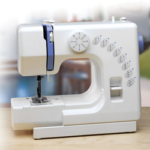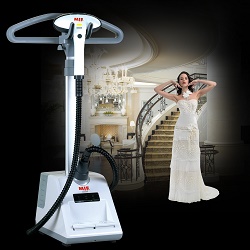What types of stitches are on modern sewing machines
Each of the sewing devices is a mini-atelier at home - the functions they represent are so varied. And not the last role in such opportunities is played by the types of lines performed on the sewing machine. It will be interesting to find out which of them are really necessary, and which you can do without. In some models of modern sewing devices, the number of lines can reach hundreds and even more. Some of them are used more often, others only in the case of decorative finishes.
Frequently used stitch patterns
Such lines are differently called "workers." And the most popular ones are straight line and seam zigzag. We present a photo of a standard panel with a choice of rows for the Astralux machine:

In addition to these two, you can bring a list of the most popular lines:
- imitation of overlock;
- for elastic materials;
- secret
- used for linings;
- making out loops.
Special paws are used for most of them - without them, high-quality task fulfillment will not work. Usually they are bundled with the device or purchased separately.
Even in a simple model, most of them will be enough to work with a large range of different fabrics - from knitwear to leather. With their help, you can perform a large number of operations - from sewing zippers to buttons and buttonholes (the last operation is performed less often).
For a novice user, more detailed information will not be superfluous, from which one can learn about the species diversity of even simple and zigzag strings. Some of them will be on the verge of worker-decorative. So, we are verified with the panel of lines of the sewing machine.
- This straight line is used where it is needed for sewing operations.

- There is a double and even triple reinforced string. It will be applied in the case when additional strength of the seam is needed. Another option is to imitate a thick thread with it (for example, sewing jeans).Such a choice will be successful for stretching fabric - this will prevent the seam from breaking (although it is better to use the same option, but only elastic).


- Approached the zigzags: if the usual is used for the edge and decorative overlay, then his elastic sibling will be better stretchable and it is used when sewing gum and sewing curtains. Stretch zigzag will also look great in darn and embroidery.


- Unusual line called "double cross"Used when sewing sportswear." It is also used for decorative purposes.

- Open overlock string - this, of course, is only a semblance of an overcast stitch. But it can be used for grinding and edge processing. This is especially true in the case of stretchable materials.

- Closed overlock stitches gets the function of processing the edges of the fabric like jersey. It is also well with its help, you can prevent the "scattering" of the edge of materials prone to this unpleasant phenomenon.

- Cell line is on the verge of decorative and working. On the one hand, it will perfectly do the ornamental processing of edges, on the other hand, it will work perfectly together with rubber bandto be tucked into the bobbin. Suitable for tensile materials.

- Will be stretchable and connecting line. As its name implies, in addition to its decorative effect (for example, in patchwork), its intended purpose is to connect the material.

- Decorative elastic stitching You can sew the fabric end to end. It is also great for joining parts with overlap, even if there is leather under the needle. Naturally, the power of her and decorative trim.

- Pullover stitch, having a compacted edge, will allow you to get stretched and obmetochnye seams on knitted things. With its help such details will be stitched. Usually she handles the product from the left edge.

- Secret line option it is intended for work with the dense not stretching fabrics. When performing such a hem it will be important to fold the fabric correctly. And for an elastic material, its corresponding counterpart should be used.


- Festoon string it is needed not only for decorative decoration - it also cuts edges, with their subsequent cutting.

- Working line recognized clothes loop. It is divided into semi-automatic (created in about four steps) and an automatic loop (which is used when sewing shirts, blouses, bed linen, and so on).

Decorative options
Usually they are performed much less frequently, and in most cases they carry purely “decoration” motifs. The range of their options is not so high, besides, not every potential user will look closely at such models, believing that he will rarely use them. What is in vain - apart from a large selection of ornamental patterns, these seams have the opportunity to imitate the simplest embroidery (from a cross and merezhka to openwork and the like).
Consider the most popular types of decorative stitches on the sewing machine.
- Sweeping linewhich is used for sewing various elements of cut. She also sweeps away the buttons or perform copy seams.

- Imitating handicraft the line is irreplaceable when working with patches. She really looks like a hand stitch.

- A narrow stalked seam can be used to sew knitwear, and you can embroider the stems in flowers or monograms. By the way, it will perfectly fasten strongly tensile options.

- Directly for working with applications It is recommended to use this eponymous option. It is also used to get a measure.

- But the stalked seam has a purely decorative purpose:

- This view is called a closed overlock line. with edge filament - it is needed to simultaneously grind and process the edges of easy-flowing fabrics.

- Need to sew patches nicely? Then it is best to use knit patch line. Especially well it will work with knitted fabrics, overcasting them.

- Incredibly beautiful patterns will create the line "cross". She, of course, has a purely decorative purpose:

- In contrast, the “mesh” can not only decorate clothes, but also be used when sewing in gum or threads.

- And merezhka became popular in the ornamental decoration of the product. Only with her must be used special needle with a blade. Here are the main types of such "sewing embroidery":



Specialized lines
A single word should be said about overlock seams: a sewing machine recreates it similar only in appearance. Being a lockstitch device (and not a chain stitch, like a flat-car stitch), it strongly pulls its threads, and therefore, does not allow them to stretch. With a large load, they will be torn or deformed, while the variant from the real overlock will return to its original position.
Interesting and loop stitches. It is better, of course, to choose the one that works in a special mode. In this case, it will be enough to put a button in a special foot, and the device will determine its size and completely under it a loop - the user will only have to cut a hole in it.
It should be noted that even with simple machines, lines can work on materials of various kinds. Therefore, it is not necessary to immediately buy an expensive unit - you can start from the middle level of electromechanical devices or from simple electronic ones.
Typically, such models contain up to 30 types of stitches, among which are suitable for knitwear, imitation of overlock and even loop-forming machines.
And if the equipment is already looked after by a professional, then we can recommend to purchase completely computerized typewriter. Most often, these units also contain full-fledged embroidery functions (up to Cyrillic and Latin). The number of lines in such models is from 50 to 1000. In addition to fully automated functions, they have another indisputable advantage - they work almost without noise.

/rating_off.png)












